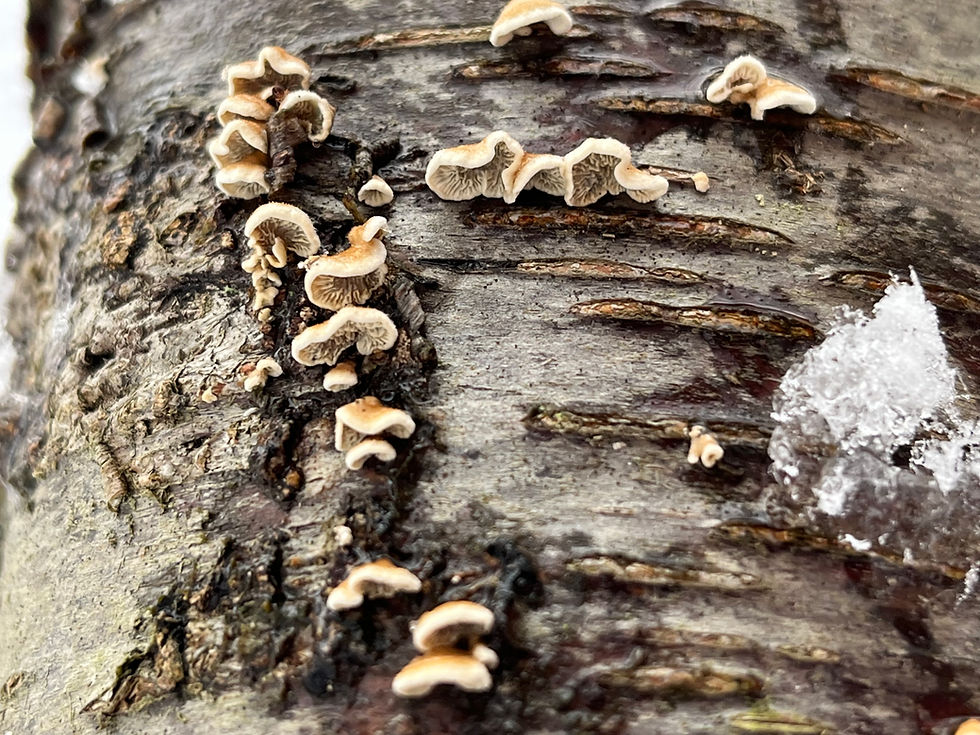Silverleaf Fungus - Chondrostereum purpureum
- Aubrey
- Dec 12, 2022
- 4 min read
Updated: Sep 21, 2023
Good evening, friends,
This week's mushroom is the Silverleaf Fungus (Chondrostereum purpureum). Just as we're putting a bow on 2022 and the fall mushroom season, I stumbled upon this peculiar purple mushroom at the base of a dead birch tree this past week. I was first introduced to this fungus by my friend Rick and I'm going to pepper in some of his pictures because he found a younger, fresher specimen - mine definitely weathered a few frosts. Regardless of when and where you find this mushroom, it looks like the very common violet-toothed polypore (Trichaptum biforme) but there's much more going on here than you garner at first glance.

Fun Facts
This fungus can be a parasite on living trees and we humans have figured out how to use it as a mycoherbicide (an herbicide derived from a fungus instead of potentially harmful, synthesized chemicals) to control certain tree populations. The discovery of the fungus as a mycoherbicide originated in the Netherlands where black cherry trees (Prunus serotina) - native to the Americas and the most abundant tree species in Central Park - were growing as an invasive species in Dutch conifer forests. Cutting the trees at the base just resulted in them regenerating several more shoots - like a hydra where two heads regenerate when one is decapitated - but some intrepid scientists discovered that a direct application of C. purpureum mycelium to the cut stems would prevent the tree from re-sprouting and initiate decay.

The mechanism through which the fungus prevents a tree from regenerating is by choking off the vascular system of the tree. This prevents the tree from sending nutrients from the roots up to the leaves and vice versa. This fungus, harnessed as a biocontrol product, is now used to prevent trees from growing under powerlines and from growing in conifer logging plots. Interestingly, if you've read Finding the Mother Tree by Suzanne Simard - perhaps a gift to yourself this holiday season if you've not yet read it - she has done research that shows birch trees boost conifer growth in commercial logging plots by sending each other carbon and other nutrients through fungal mycelium. While eliminating every tree that won't be harvested in a logging forest may be a misguided use for this mycoherbicide, it's at least better than spraying harsh chemicals that could leach into groundwater and have other negative externalities.
The fungus is most often found on fruit bearing trees like apples (Malus) and cherries (Prunus) where it will cause some of the leaves on afflicted trees to turn a matte silver color - hence the common name "Silverleaf Fungus". An infected tree will decline in health until it's vascular system is completely choked, but the fungal spread is not aggressive enough to destroy entire harvests/orchards and the economic impact is seen as negligible (per the College of Agriculture and Natural Resources at Michigan State University, Reference 4). Regardless, the rule of thumb is to avoid pruning these fruit trees in the late fall/winter while this mushroom is producing spores.

Ecology
We've already discussed how the fungus can act as a parasite, but from what I read it seems that it is weakly parasitic and primarily saprobic - acting as a decomposer to digest dead trees. It is known as a "primary decomposer" and is one of the first fungi to colonize wood after it dies - perhaps because it was already in the tree as a parasite. I revisited the fungus today to see how it appeared with a coating of fresh snow (nothing remarkable, it was mostly buried underneath it) but I did notice another species of fungus (Plicaturopsis crispa) popping out a few feet above our Silverleaf on the same tree. It's not a mushroom we've looked at yet, but it's also an early colonizer of dead wood, and perhaps we'll take a longer look at it next week...

The fruiting bodies of C. purpureum grow predominantly in the late fall, with iNaturalist observations peaking in November, and the fungus seems to be indigenous to temperate forests of the northern hemisphere. However, it can now be found on every continent besides Antarctica as it's liable to grow wherever there are apple and cherry orchards.
The fruiting bodies are rubbery and had a pungent "mushroomy", chlorine-like smell. Unlike the violet-toothed polypore, this mushroom doesn't have any visible pores/teeth. As the mushroom ages it will go from the gorgeous white and purple in Rick's photo to the dull brown I documented - retaining those flashy colors of youth only at the margins. A trait some of us may notice in ourselves as the years continue to tick away. One last neat feature was made evident when I removed a leaf from one of the larger fruiting bodies and saw that it had basically become fossilized on the fungus:

Hope you enjoyed the first snowfall of the year and let's hope for many more to come,
Aubrey
A bonus Rick photo to take us out:

References:
1) Hamberg, L., Saksa, T. & Hantula, J. Role and function of Chondrostereum purpureum in biocontrol of trees. Appl Microbiol Biotechnol105, 431–440 (2021). https://doi.org/10.1007/s00253-020-11053-5
2) https://www.sciencedirect.com/topics/agricultural-and-biological-sciences/chondrostereum-purpureum
5) Rick's photos and iNaturalist profile: https://www.inaturalist.org/observations/139876970
